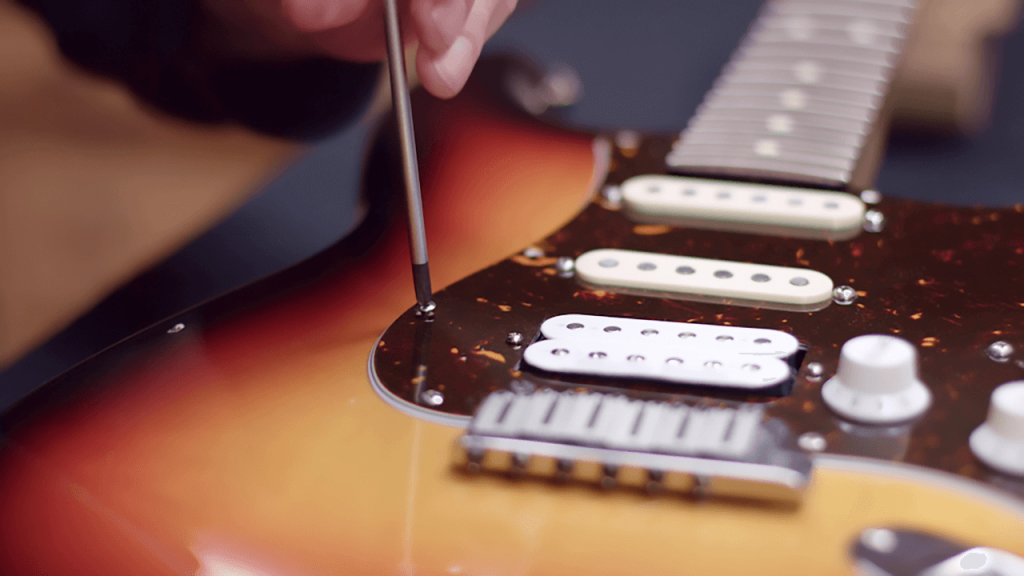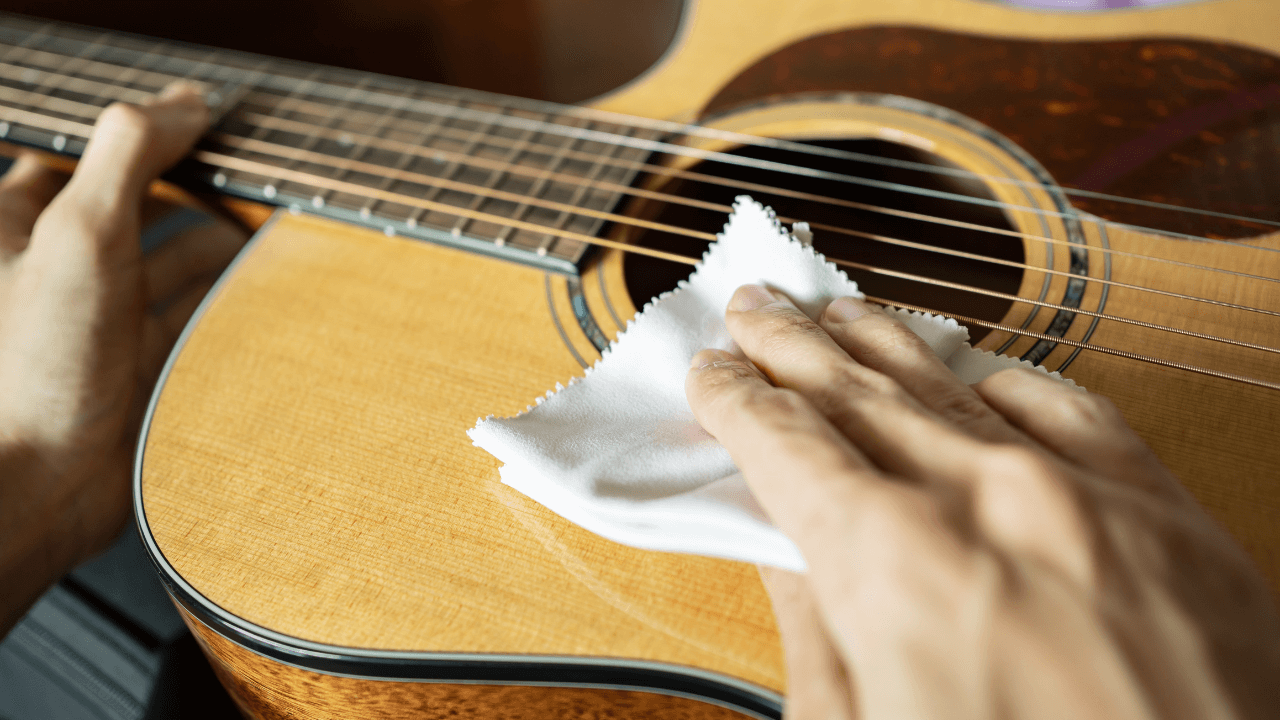Keeping your guitar clean is crucial for maintaining its longevity and ensuring optimal playability. Regular cleaning not only enhances the instrument’s appearance but also prevents the buildup of dirt, grime, and oils that can affect the sound quality and overall performance.
In this in-depth guide, we will take you through the step-by-step process of cleaning your guitar, covering everything from the basic cleaning routine to more specific techniques for fretboards, necks, and different types of guitars.
By following these instructions, you can ensure that your guitar remains in top condition for years to come.
How to clean a guitar | Things You Will Need
To begin cleaning your guitar, gather the following supplies:
- Soft, lint-free microfiber cloths
- Guitar polish or cleaner (appropriate for your guitar’s finish)
- Guitar string cleaner/lubricant
- Fretboard cleaner
- Lemon oil (for certain fretboard types)
- Q-tips or a soft-bristle toothbrush
- Small screwdriver (if necessary for removing components)
- Guitar polish cloth or polishing pad
Steps to Clean Your Guitar
Prepare the workspace: Find a clean and well-lit area to work on your guitar. Place a soft cloth or towel on a flat surface to prevent any accidental scratches.
Remove the strings (optional): If you prefer a thorough cleaning, removing the strings can give you better access to various parts of the guitar. However, this step is not necessary for routine cleaning.
Wipe down the guitar body: Take a dry microfiber cloth and gently wipe the guitar body to remove any dust or fingerprints. For stubborn grime, use a guitar cleaner or polish suitable for your guitar’s finish.
Clean the hardware: Use a soft cloth dampened with a mild guitar cleaner or polish to clean the hardware, such as tuners, bridge, and pickups. Take care not to use excessive moisture.
Clean the guitar fretboard: Move on to cleaning the fretboard using appropriate techniques based on the fretboard type.
Clean the guitar neck: Follow the instructions provided in the next section to clean the neck thoroughly.
Re-string and tune: If you removed the strings, now is the time to re-string your guitar. After re-stringing, tune the guitar to your desired pitch.
How to clean a guitar fretboard
This is the part where we teach you how to clean a guitar fretboard. There are a couple of nuances so read it carefully.

Types of Fretboards
Rosewood: Common on many guitars, it requires regular cleaning and conditioning.
Maple: Sealed and doesn’t require conditioning, only occasional cleaning.
Ebony: Similar to rosewood, but with a denser grain.
Preparing the Fretboard for Cleaning
Loosen the strings: Slightly loosen the guitar strings to provide better access to the fretboard.
Protect the guitar body: Cover the guitar body with a cloth or masking tape to prevent any cleaning agents from touching the finish.
Cleaning the Fretboard
Apply fretboard cleaner: Use a small amount of fretboard cleaner or mild soapy water on a cloth or soft toothbrush. Gently rub the fretboard lengthwise to remove dirt and grime.
Clean frets and edges: Use a toothbrush or a soft cloth with fretboard cleaner to clean the frets and the edges around them. Pay attention to removing any built-up residue.
Oiling the Fretboard (for Rosewood and Ebony)
Apply lemon oil: Using a clean cloth or applicator, apply a small amount of lemon oil to the fretboard. Rub it gently into the wood, covering the entire surface.
Wipe off excess oil: After allowing the oil to penetrate the wood for a few minutes, wipe off any excess oil with a dry cloth.
How to clean a guitar neck
Now let’s learn how to clean a guitar neck. Doesn’t matter what type of guitar it is. This guide will teach you how to clean any type of guitar neck.

Preparing the Neck for Cleaning
Remove any debris: Use a soft cloth or brush to remove loose dirt and debris from the neck.
Loosen the strings: Slightly loosen the guitar strings to provide better access to the neck.
Cleaning the Neck
Use a soft cloth: Moisten a soft cloth with a small amount of guitar cleaner or mild soapy water. Gently wipe down the neck, paying attention to the back and sides.
Remove stubborn grime: For sticky residue, use a cloth slightly dampened with rubbing alcohol. Be cautious not to use excessive alcohol, as it can damage the finish.
How to clean a guitar body
Cleaning the guitar body is an essential part of maintaining its appearance and preserving the finish. Here’s a step-by-step guide on how to clean the guitar body effectively:

Prepare the workspace: Find a clean, well-lit area to work on your guitar. Place a soft cloth or towel on a flat surface to prevent any accidental scratches.
Gather the necessary supplies: You will need a soft, lint-free microfiber cloth and a suitable guitar polish or cleaner specifically formulated for your guitar’s finish. Ensure that the cleaner is non-abrasive and safe to use.
Remove dirt and dust: Start by using a dry microfiber cloth to gently wipe down the entire guitar body. This step helps remove loose dirt, dust, and fingerprints.
Apply the guitar cleaner: Dampen the microfiber cloth slightly with the guitar polish or cleaner. Make sure not to saturate the cloth with excessive moisture.
Clean the guitar body: Begin wiping the guitar body using the dampened cloth. Use gentle, circular motions to clean the surface, paying attention to any areas with noticeable grime or smudges. Avoid excessive pressure that may scratch the finish.
Focus on problem areas: If you encounter stubborn grime or smudges, apply a little more pressure and continue to clean the affected area. Take care to use only the cleaner and cloth to avoid scratching the finish with other abrasive materials.
Wipe off excess cleaner: Once you’ve cleaned the entire body, use a separate, dry microfiber cloth to wipe off any excess cleaner residue. This step ensures a streak-free finish.
Polish the body (optional): If desired, you can further enhance the guitar’s shine by using a guitar polish. Apply a small amount of polish to a clean section of the microfiber cloth and gently buff the guitar body in circular motions. Be sure to follow the polish manufacturer’s instructions for best results.
Final inspection: After cleaning and polishing, inspect the guitar body to ensure that it is clean and free of any remaining dirt or smudges. Take a moment to admire the renewed shine of your instrument.
Remember, different guitar finishes may have specific care instructions, so always refer to the manufacturer’s recommendations. Regular cleaning will help preserve the finish and keep your guitar looking its best.
How to clean guitar strings
Cleaning guitar strings is an important part of maintenance as it helps prolong their lifespan, maintains their tone, and prevents the buildup of dirt, oils, and grime.

Follow these steps to effectively clean your guitar strings:
Prepare the workspace: Find a clean and well-lit area to work on your guitar. Place a soft cloth or towel on a flat surface to prevent any accidental scratches.
Gather the necessary supplies: You will need a soft cloth, guitar string cleaner/lubricant, and possibly a soft-bristle toothbrush or Q-tips for hard-to-reach areas.
Loosen the strings (optional): If you prefer a more thorough cleaning, you can loosen the guitar strings by turning the tuning pegs slightly. This step provides better access to the entire string surface. However, if you’re short on time, you can clean the strings without loosening them.
Wipe down the strings: Take a soft cloth and run it along each string, starting from the bridge towards the nut. Apply gentle pressure to remove dirt, oils, and debris. You can use a back-and-forth motion or press the cloth against the strings and slide it along their length.
Use a string cleaner/lubricant: Apply a small amount of guitar string cleaner/lubricant onto a cloth or directly onto the strings. These products help remove dirt and grime while lubricating the strings to reduce friction and improve playability.
Clean the strings with a cloth: With the cleaner/lubricant applied, use the cloth to wipe down each string individually. Slide the cloth up and down the string’s length, ensuring that you cover the entire surface. Repeat this process for all the strings.
Clean hard-to-reach areas (optional): If there are tight spots between the strings or around the bridge saddles, you can use a soft-bristle toothbrush or Q-tips moistened with the string cleaner/lubricant. Gently scrub these areas to remove any stubborn grime.
Wipe off excess cleaner/lubricant: After cleaning the strings, use a dry cloth to wipe off any excess cleaner or lubricant residue. This step ensures that your strings are not overly slippery and prevents any buildup of the product.
Retune your guitar: If you loosened the strings during the cleaning process, now is the time to retune your guitar. Use a tuner to bring each string back to its proper pitch.
How to clean an acoustic guitar

Cleaning an acoustic guitar follows the general cleaning instructions mentioned above. However, note the following points specific to acoustic guitars:
- Avoid excessive moisture or liquid near the soundhole or inside the guitar body.
- Use a humidifier to maintain optimal humidity levels, preventing damage to the wood.
- Clean the soundhole area with a soft cloth or brush to remove dust or debris.
How to clean an electric guitar

Cleaning an electric guitar also follows the general cleaning instructions mentioned at the beginning of the post. Additionally, consider the following points specific to electric guitars:
- Pay attention to the electronic components and connections while cleaning the body and hardware.
- Clean the pickups with a dry cloth or a specialized pickup cleaner to remove any accumulated dust or debris.
- Inspect the volume and tone knobs for grime buildup and clean them using a soft cloth and mild soapy water, if necessary.
Conclusion
Regularly cleaning your guitar is an essential part of proper maintenance and care. By following the steps outlined in this comprehensive guide, you can effectively clean different parts of your guitar, including the fretboard, neck, and body.
Remember to use suitable products and techniques based on your guitar’s specific materials and finish.
With proper cleaning, you’ll not only keep your guitar looking its best but also ensure that it performs at its optimal level for years to come.

